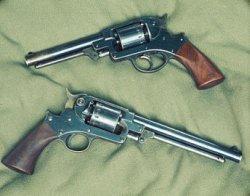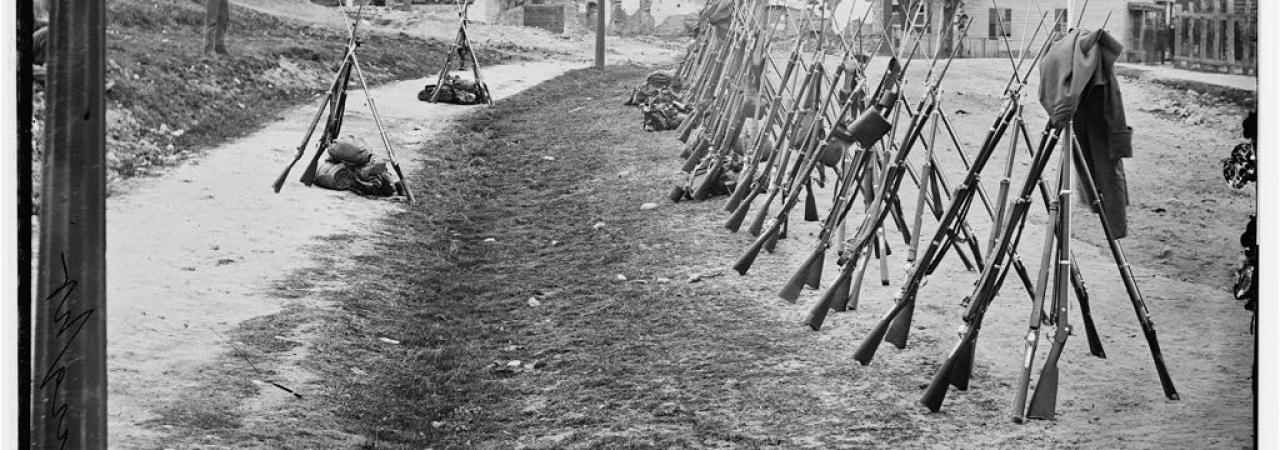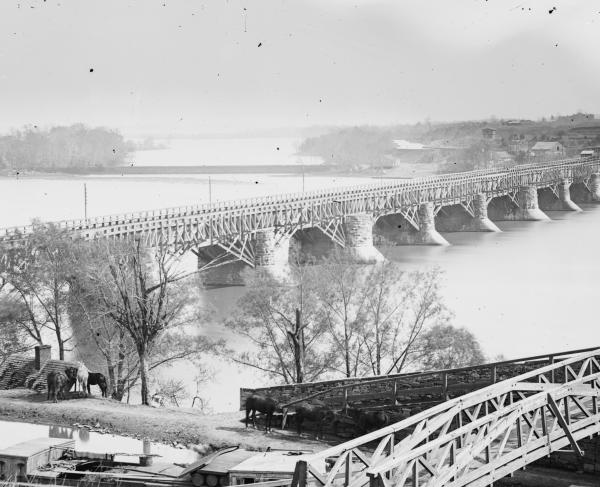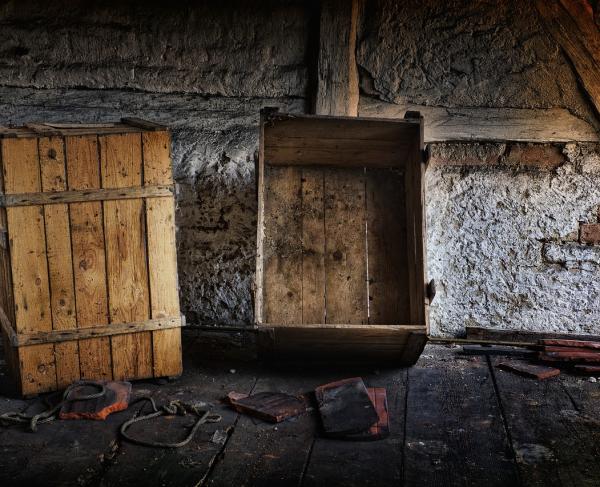The Civil War witnessed a technological revolution in weaponry. This was highlighted by a changeover in shoulder-fired weapons from smoothbore firearms that had to be loaded through the muzzle each time a shot was fired to rifled-barrel firearms, some of which loaded at the breech. Most of these new rifle-muskets still had to be loaded between each shot, but repeating weapons such as 7-shot Spencer and 16-shot Henry rifles and carbines were developed as well. Unfortunately for the common soldier, tactics did not advance as quickly as technology. Napoleonic linear tactics from earlier in the century now combined with more accurate, faster-firing weapons to result in catastrophic casualty figures throughout the War.

The Confederacy, whose industrial base was far weaker than the Union's when the war began, accomplished a great feat by establishing a viable arms-manufacturing capability in short order. The North's industrial machine also swung into high gear to produce huge quantities of weapons and ammunition. Agents from both the Union and the Confederacy scoured the shelves of European arms-dealers to ensure that their armies had an adequate supply of weapons. Most Confederate infantrymen favored the English-manufactured Enfield.
Cavalry
Although they most often fought on foot—particularly as the War progressed—cavalry units typically looked for firearms that would be easy to reload from the back of a galloping horse. Cavalry in both the Union and the Confederate Armies employed a variety of breech-loading, single-shot, rifle-barreled weapons known as carbines. The carbines, because their barrels were several inches shorter than the rifle-muskets the infantry carried, also had a shorter range. In addition, the cavalry weapons had a brutal recoil when fired, and—despite their advantages in loading—most still required the cavalry soldier to manipulate a tiny cap in order to fire. Confederate cavalry often brought sawed-off shotguns and cut-down hunting rifles from home. Others used the standard infantry rifle-muskets, though the longer barrels were awkward and muzzle-loading was difficult on horseback.
The storm of battle [at Chickamauga] was sweeping over the ground I had just left. Hastily...returning, I found the 39th Indiana regiment coming from a cross-road,--a full, fresh regiment, armed with Spencer's repeating-rifles, the only mounted force in our army corps...Colonel T.J. Harrison, its commander...dismounting his men, dashed at the enemy in a most effective charge. [Colonel John T.] Wilder, coming up on our right, also attacked. Wilder had two regiments armed with the same repeating-rifles. They did splendid work. [Confederate General James] Longstreet told Wilder after the war that the steady and continued racket of these guns led him to think an army corps had attacked his left flank."
- Union officer Gates P. Thruston. (From Battles and Leaders of the Civil War, Vol. III, published by Castle.)

In addition to the carbines, cavalrymen also frequently were issued percussion revolvers. These handguns used rotating cylinders, bored through with five or six chambers, to allow multiple shots without reloading. The soldier had to pour a powder charge into the chamber, ram a round or conical ball on top, seal the front of the cylinder with grease to prevent one chamber from igniting the adjacent ones, and then place a cap on the rear of each chamber before the guns were ready to be fired. Once this time-consuming process was complete, the soldier could rely on five or six shots in succession. However, the sights on the handguns were crude; a soldier could not expect to hit any target much beyond 50 paces—less from horseback.
One massive Confederate revolver, the LeMat, clustered nine pistol chambers around a central shotgun barrel. Smith & Wesson perfected self-contained metallic cartridge revolvers in .22 and .32 caliber. Earlier cartridges had been made of stiff paper or animal skin wrapped around the charge, primer, and projectile of the gun. While more convenient to load and carry, these smaller guns lacked the power of their .36 and .44 caliber percussion competition. One French revolver, the Lefauchaux, used a small firing pin integral to the cartridge to ignite the charge. Federal forces used several thousand of the Lefauchaux revolvers, and Confederate Generals J.E.B. Stuart and Pierre Beauregard also carried this model. The preferred weapon of Nathan Bedford Forrest’s Confederate horse soldiers was a pair of the .36 caliber Navy revolvers manufactured by Colt which Forrest believed was far superior to the Yankee infantry’s bayonet.
Infantry
Most Civil War infantrymen, both Federal and Confederate, carried .58 or .577 caliber rifle-muskets. The rifle-musket was first manufactured in the United States in 1855 and quickly replaced earlier smoothbore guns. The rifling—spiral grooves etched inside the gun’s barrel—greatly increased the accuracy of the weapons by spinning and stabilizing the bullet as it sped towards the target. A trained marksman could hit targets as far as 800 yards away, and even an average shot could expect to strike the mark at 250 yards. Smoothbore muskets, some of which were still used during the Civil War, were generally unreliable at any range more than 75 yards.

These rifle-muskets were chiefly percussion weapons; pulling the trigger of a rifle-musket caused the weapon’s hammer to strike a small metal cap. A charge of fulminate of mercury inside the cap would explode to ignite the gunpowder charge in the barrel. The force of the gunpowder explosion drove the bullet, either a round ball or minie ball, down the barrel. The metal cap was tiny, about the size of a pencil-eraser, and had to be set into place by hand each time the musket was fired. Soldiers had to follow nine careful steps to load and fire a single bullet from a muzzle-loading gun, and five to fire a breech-loading weapon. Rifle-muskets weighed between six and ten pounds and many were designed to fit a bayonet on the end of the barrel.
After we had abandoned the line, and on coming to a little stream of water, I undressed for the purpose of bathing, and after undressing found my arm all battered and bruised and bloodshot from my wrist to my shoulder, and as sore as a blister. I had shot one hundred and twenty times that day. My gun became so hot that frequently the powder would flash before I could ram home the ball, and I had frequently to exchange my gun for that of a dead comrade.
- Confederate Private Sam R. Watkins, 1st Tennessee Regiment. (From "Co. Aytch" by Sam R. Watkins, published by Collier Books.)
One of the most highly rated of the rifle-muskets was manufactured at the United States Arsenal at Springfield, Massachusetts (or at other armories under license). Other prominent U.S. gun makers included Colt and Remington. In addition, rifle-muskets could be imported from Europe. During the early campaigns, Confederate soldiers often armed themselves with captured Federal Springfields. Both the Federal and Confederate armies also carried large numbers of English Enfield rifle-muskets as well as Austrian, Prussian, French, and Belgian guns. The quality of imported guns ranged from the first-rate Enfield (equal or superior to the Springfield) to barely functional.
On the 13th, marched 10 miles, to camp Stanton, on big prairie in Missouri. Target shooting was practiced here by companies for the first time, and the muskets, owing to their large calibre and forcible shooting, were dubbed by the Col. "light artillery," causing much amusement."
- From the newspaper of the 11th Kansas Volunteers, Buck & Ball, December 6, 1862.
The Confederacy captured the gun-making equipment at the U.S. Armory at Harpers Ferry, Virginia (now West Virginia) in 1861. The Southerners used the Harpers Ferry machinery to establish factories in Richmond, Virginia and at the Fayetteville, North Carolina arsenal that manufactured guns very similar to the standard Federal rifle-musket. Other Southern arsenals turned out small quantities of Enfield-style weapons and copies of Colt & Whitney revolvers as well as a few designs of their own.
In addition to standard muzzle-loading rifle-muskets, a few Civil War infantrymen carried breech-loading guns (like the Sharps) or repeaters (like the Spencer and Henry). Breech-loading weapons were easier and faster to reload than muzzle-loaders--even from a position flat on the ground. Repeaters offered an additional advantage since they could be fired--in the case of the Henry--up to twenty times without reloading. Although the breech-loaders and the repeaters were only a small percentage of the total number of guns used by Civil War infantrymen, units that carried these weapons gained a distinct edge over even much larger enemy forces.



